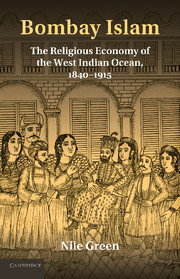Book contents
- Frontmatter
- Contents
- Illustrations
- Acknowledgements
- Maps
- Introduction
- 1 Missionaries and Reformists in the Market of Islams
- 2 Cosmopolitan Cults and the Economy of Miracles
- 3 The Enchantment of Industrial Communications
- 4 Exports for an Iranian Marketplace
- 5 The Making of a Neo-Ismā‘īlism
- 6 A Theology for the Mills and Dockyards
- 7 Bombay Islam in the Ocean's Southern City
- Conclusions
- Notes
- Bibliography
- Index
3 - The Enchantment of Industrial Communications
Published online by Cambridge University Press: 03 May 2011
- Frontmatter
- Contents
- Illustrations
- Acknowledgements
- Maps
- Introduction
- 1 Missionaries and Reformists in the Market of Islams
- 2 Cosmopolitan Cults and the Economy of Miracles
- 3 The Enchantment of Industrial Communications
- 4 Exports for an Iranian Marketplace
- 5 The Making of a Neo-Ismā‘īlism
- 6 A Theology for the Mills and Dockyards
- 7 Bombay Islam in the Ocean's Southern City
- Conclusions
- Notes
- Bibliography
- Index
Summary
ALTERNATIVE TRAJECTORIES OF COMMUNICATIONAL MODERNITY
The industrialization of communication among Muslims was one of the major overall characteristics of Bombay's religious economy. Powered by the spread of cheap mass-produced paper and inexpensive iron printing-presses, Bombay's industrialization enabled the city to become the most important Muslim printing centre in the Indian Ocean. Not only did this industrialization of communications mean that the varied textual productions of Bombay's religious economy were mass-produced in a period in which printing was comparatively underdeveloped in Bombay's oceanic and continental hinterlands, it also enabled the distribution of both the textual and embodied productions of the religious economy through the export of books and holy men on the steamship networks that Bombay similarly dominated. While this was an industrially enabled pattern of reproduction and distribution, such reliance on machines and steam-power no more led to a disenchanted religiosity in Bombay than it did in mill-towns such as Manchester or Ashton-under-Lyne in the age of such ocean-going charismatics as the ‘Shaker’ Ann Lee and the Yorkshire prophet John Wroe, whose heaven-sent visions were filled with steam-belching engines and flying iron sky-trains. With regard to Muslim contexts, the spread of printing and the acceleration of travel through the development of steamships and ocean liners have usually been associated with the emergence of Islamic Reform. In contrast to the abundant literature associating the spread of modern communications with Modernist, Protestant or Pan-Islamist Islams, this chapter argues that such communications as printing and travel were neutral technologies that could be and were made use of by the full range of religious firms operating in the religious economy of a given region.
- Type
- Chapter
- Information
- Bombay IslamThe Religious Economy of the West Indian Ocean, 1840–1915, pp. 90 - 117Publisher: Cambridge University PressPrint publication year: 2011



